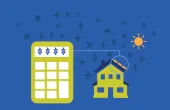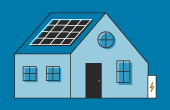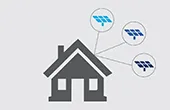Electricity is not the only thing that can be created by harnessing the sun’s energy. One of the most economical ways to take advantage of the sun’s power is to design your property with passive solar design in mind, or to say, to take full advantage of the site, materials, and climate of your home to maximize efficiency and minimize energy usage overall.
Continue readingQ&A with CollectiveSun
As more and more homeowners and businesses go solar, it’s important that we increase the accessibility of solar financing to reach more groups of people. For example, while nonprofits aren’t able to directly benefit from the investment tax credit (ITC) or other tax based solar incentives, there are still companies that can help them maximize their solar savings. CollectiveSun is one such company – in fact, they work exclusively with nonprofits and tax exempt organizations to help make solar more financially accessible, providing a 12 percent discount on solar on projects 50 kilowatts (kW) or greater. We sat down with CollectiveSun to learn more about their company and their financial offerings.
Continue readingPowering through: 2020 NREL study reveals the true longevity of solar
One of the most common statements you’ll hear us say about solar is that it’s a great investment. Among many reasons, we say this because solar panels last a long time. Most solar panel manufacturers now offer warranties between 20 and 25 years, with some going even longer. The average payback period in the US is around eight years, meaning you’ll save substantial amounts of money for well over half of your system’s lifetime.
But warrantied production is one thing and actual performance is another altogether. So, how well do panels actually perform as they age? A 2020 study by the National Renewable Energy Laboratory (NREL), PV field reliability status—Analysis of 100 000 solar systems, provides some compelling insights.
Continue readingGreen power plans, community choice aggregation, community solar: why we recommend community solar
From green power plans to community choice aggregation to community solar, there are an increasing number of options when it comes to electricity these days, and understandably, it’s not always easy to make a decision.
While we at EnergySage are onboard with any power options that support the environment and further decarbonize our electricity, we’re especially excited about community solar – in this article, we’ll explain a few reasons why.
Continue readingRecycling solar batteries and electric car batteries: what you need to know about lithium-ion battery recycling
Electric vehicles (EVs) are all the rage – and might just be the centerpiece to the clean energy revolution. There’s a catch, however. Along with all of those electric cars comes an equal amount of lithium-ion batteries to power them, and recycling those batteries is a complicated, but necessary, problem to solve. What’s more, home batteries like the Tesla Powerwall are usually made of very similar materials to EV batteries, so there’s even more to recycle.
Similar to solar panel recycling, it’s expensive and difficult to separate out the components of a lithium-ion battery to the point where they can be recycled and reused. Nowadays, lithium-ion battery recycling exists, but not nearly on the scale and at the efficiency we need it to as batteries become more and more popular.
Continue readingSolar news: August 20th, 2021
In this week’s news round-up, we discuss a new startup company looking to innovate electric vehicle (EV) charging infrastructure, as well as an updated projection on the country’s energy future from the federal government.
Continue readingThe infrastructure bill and budget reconciliation bill: what could they mean for clean energy?
On Earth Day 2021, the Biden Administration announced its goal “to reach 100 percent carbon pollution-free electricity by 2035”– but, until recently, no legislation had been passed to actually meet this target. This all started to shift in August 2021, when the Senate passed a $1.2 trillion infrastructure bill and then immediately advanced a $3.5 trillion budget resolution that will lay the framework for a reconciliation bill. So, what’s the status of these bills? And how will they advance the U.S.’s clean energy transition?
Continue readingWhat does the new Intergovernmental Panel on Climate Change report mean for you?
On August 9, 2021, the Intergovernmental Panel on Climate Change (IPCC) released the world’s largest report on climate change, which the United Nations (UN) Secretary-General called “a code red for humanity.” The report synthesized information from over 14,000 references to assess current impacts of climate change and future risks, both on global and regional scales. But why is this report so important and how could its findings impact you?
Continue readingHome wind turbines: are they right for you?
Not every property is suitable for solar panels. However, that does not mean that you won’t be able to generate clean energy on your property. One renewable energy technology that’s becoming an increasingly popular alternative for homeowners looking to generate their own clean electricity is small wind turbines.
Continue readingWhat do electricity bills look like with solar? My experience after two years
If you’re considering solar, it can be easy to imagine what solar panels would look like on your home: with nearly three million homes already installing solar around the country, you’re probably familiar with what solar panels look like on a roof. What can be harder to visualize is what your electricity bills will look like after going solar. Clearly, solar can save you money on your utility bills, but how does it actually work?
With that in mind, here’s a look at what my National Grid bills looked like before solar, what they look like now that I’ve had solar for two years, and some bonus screenshots of how my usage has changed with additional energy upgrades. As an EnergySage employee, I’m obviously a solar advocate, and we certainly care about our environmental impact. But, we wouldn’t have gone solar unless it made financial sense, and it most certainly did: I haven’t paid an electric bill for my home in Massachusetts since September 2019, which is just as great as it sounds.
Continue reading




